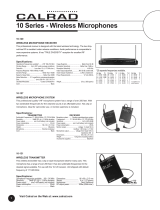
Table of contents
6452_en_09 PHOENIX CONTACT 5 / 196
9 Diagnostic and status indicators ..............................................................................................95
9.1 Indicators on Inline Modular IO terminals............................................................. 95
9.1.1 Indicators on bus couplers and terminals with remote bus branch ....... 95
9.1.2 Indicators available on different terminals in the Inline system .............96
9.1.3 Indicators on power and segment terminals .........................................97
9.1.4 Indicators on I/O terminals .................................................................. 98
9.1.5 Indicators on power-level terminals ....................................................101
9.2 Indicators on Inline Block IO modules................................................................102
9.2.1 Indicators in the bus system function area (BUS) ...............................102
9.2.2 Indicators in the supply function area (PWR) ..................................... 103
9.2.3 Indicators in the I/O function area (IN, OUT, IN/OUT) ........................ 104
10 Mounting/removing devices ...................................................................................................107
10.1 Installation instructions ...................................................................................... 107
10.1.1 Unpacking ..........................................................................................107
10.1.2 Replacing a device ............................................................................ 107
10.2 Basic information about mounting .....................................................................108
10.3 Mounting distances ........................................................................................... 110
10.3.1 Mounting distances for Inline Modular IO terminals ........................... 110
10.3.2 Mounting distances for Inline Block IO modules ................................ 114
10.4 Grounding concept ...........................................................................................115
10.4.1 Functional earth ground (FE) ............................................................. 115
10.4.2 Protective earth ground (PE) (Inline Modular IO) ............................... 117
10.5 Shielding concept..............................................................................................118
10.5.1 Inline shielding concept ...................................................................... 118
10.5.2 Shielding when connecting analog sensors and actuators .................118
10.6 Mounting/removal.............................................................................................. 120
10.6.1 Inline Modular IO: Mounting/removal ................................................. 120
10.6.2 Inline Block IO: Mounting/removal .....................................................128
10.6.3 Order of the Inline Modular IO terminals ............................................ 129
11 Connecting cables .................................................................................................................133
11.1 Connecting cables using Inline connectors ....................................................... 133
11.1.1 Connecting unshielded cables ........................................................... 133
11.1.2 Connecting shielded cables using an Inline shield connector ............ 134
11.1.3 Connecting shielded cables using an Inline connector ......................137
11.2 Connecting the power supplies .........................................................................138
11.2.1 Inline Modular IO: Supply options ......................................................138
11.2.2 Power supply requirements ............................................................ 139
11.3 Recommendation for supplying the supply voltage and resetting the
voltage with regard to Inline Modular .................................................................140
11.3.1 Supply at the bus head ...................................................................... 140
11.3.2 Supply at power terminals and boost terminals ..................................141





















